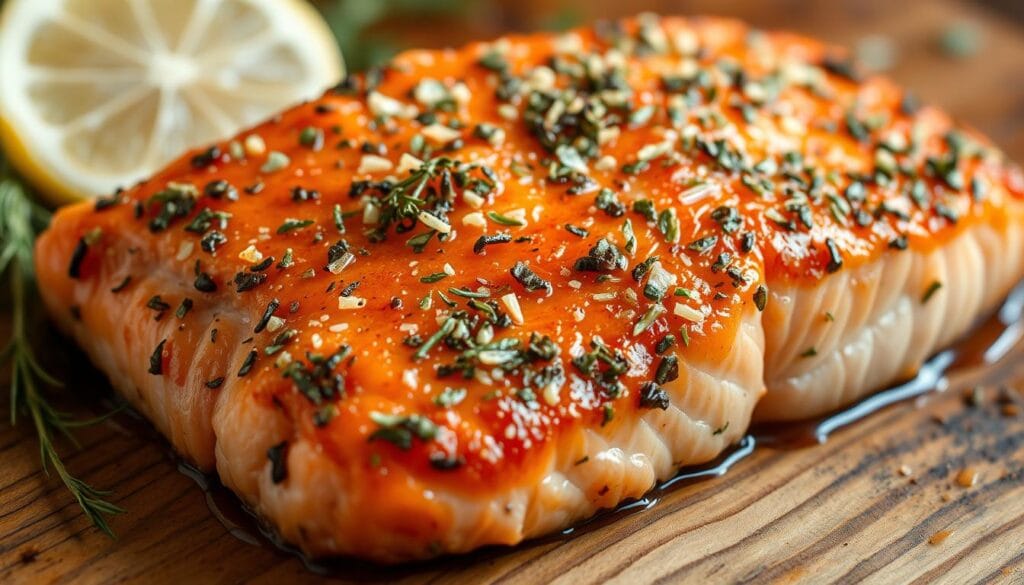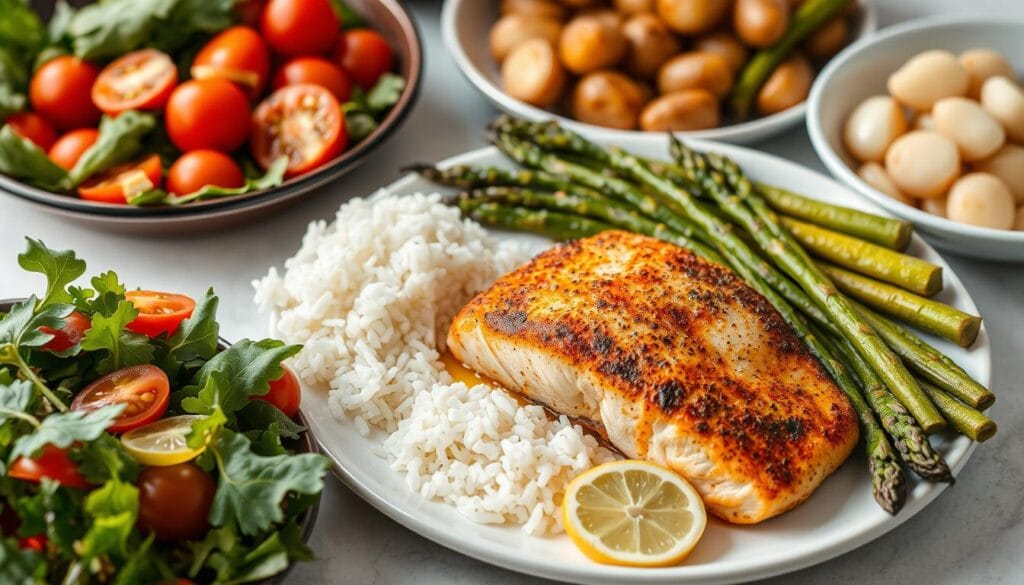Imagine this: after a long day, you crave a meal that feels special but doesn’t demand hours in the kitchen. A golden-brown, perfectly flaky dish that leaves your kitchen smelling like a cozy restaurant. That’s the magic of mastering a simple yet impressive recipe—salmon fillet in oven – one that balances health and indulgence without compromise.
What if you could create a tender, flavorful centerpiece using just a handful of pantry staples? With a no-fuss approach, this method relies on olive oil, fresh lemon, and garlic to elevate your weeknight dinners or weekend gatherings. Whether you’re new to cooking or a seasoned pro, the results are consistently satisfying.
Think crispy edges, moist flesh, and a burst of citrusy brightness in every bite. Best of all? You won’t need complicated tools or hard-to-find ingredients. This technique adapts to your preferences, letting you experiment with herbs, spices, or even a drizzle of honey for a touch of sweetness.
Key Takeaways
- Learn a quick, healthy method for preparing restaurant-quality meals at home.
- Discover how olive oil and lemon enhance flavor while keeping dishes light.
- Master a versatile technique suitable for busy nights or celebratory dinners.
- Use accessible ingredients to create multiple recipe variations effortlessly.
- Achieve crispy texture and tender results with precise oven temperatures.
Introduction to Oven-Baked Salmon
Craving a dish that’s both quick and impressive? Oven-baking unlocks crispy perfection with minimal effort. This method turns basic ingredients into a flavor-packed centerpiece in under 30 minutes—ideal for hectic evenings or last-minute guests.
Why This Method Wins Over Busy Cooks
Preheat your oven, and let the heat work its magic. Garlic-infused olive oil creates golden edges while sealing in moisture. No babysitting required—just season, bake, and enjoy. You’ll spend less time cooking and more savoring.
“Garlic butter transforms simple proteins into crave-worthy meals. It’s the secret weapon for home chefs.”
Home Kitchen Advantages You Can’t Ignore
Control ingredients and portion sizes without restaurant markups. Plus, cleanup is a breeze compared to stovetop splatters. Check out how homemade stacks up:
| Factor | Homemade | Takeout |
|---|---|---|
| Prep Time | 10 minutes | 30+ minutes |
| Cost Per Serving | $5.50 | $18+ |
| Flavor Control | Customizable | Fixed |
| Cleanup | One pan | Packaging waste |
Fresh lemon zest or rosemary sprigs add personality to your recipe. Swap seasonings weekly to keep dinners exciting—no two meals need taste alike!
Essential Ingredients for Your Salmon Recipe
Every masterpiece begins with premium building blocks. The right combination of fresh components and smart seasoning choices transforms basic cooking into culinary artistry. Let’s explore what makes your dish shine.
Selecting Fresh, High-Quality Fillets
Look for firm, glistening flesh with no fishy odor. Bright orange-red color indicates freshness, while dull or brown spots suggest aging. Press gently—the surface should spring back immediately.
| Quality Indicator | Fresh | Avoid |
|---|---|---|
| Color | Vibrant pink-orange | Grayish tint |
| Texture | Moist & firm | Mushy or dry |
| Smell | Ocean breeze | Ammonia-like |
Key Seasonings and Olive Oil Choices
Extra virgin olive oil creates golden crusts without overpowering delicate flavors. Chef Michael Romano notes: “Kosher salt’s coarse grains season evenly—unlike table salt that can create harsh spots.”
Combine these essentials for maximum impact:
- Cold-pressed EVOO (high smoke point)
- Freshly ground black pepper
- Citrus zest for brightness
Remember: precise baking temperatures help ingredients work together. A 400°F oven caramelizes surfaces while keeping interiors tender. Adjust seasoning amounts based on your piece’s thickness—thicker cuts need bolder flavors.
Step-by-Step Guide to Prepping Your Salmon
Transform your kitchen into a gourmet workspace with three simple stages. Proper preparation ensures crispy results without last-minute scrambling. Let’s build your foundation for success.
Preheating and Preparing Your Oven
Start by setting your oven to 400°F—this temperature caramelizes surfaces while preventing dryness. Line a rimmed baking sheet with foil or parchment paper. Chef Elena Parker advises: “A light olive oil coating prevents sticking and boosts browning.”
Compare these methods for best results:
| Surface Prep | Advantage | Drawback |
|---|---|---|
| Bare Sheet | Maximum crispness | Harder cleanup |
| Oiled Foil | Easy removal | Less browning |
| Parchment | Non-stick safety | No oil needed |
Arranging and Seasoning the Fillets
Pat your fish dry with paper towels—moisture steams instead of searing. Place pieces skin-side down if intact, leaving 1″ between them. Drizzle olive oil first to help spices adhere.
Follow this sequence for flavor-packed results:
- Rub oil over all sides
- Sprinkle kosher salt evenly
- Add cracked pepper and optional herbs
For sheet pan recipes, add lemon slices or garlic cloves around the edges. Rotate halfway if your oven has hot spots. This method works for multiple protein types, letting you master one technique for countless meals.
Mastering Baking Techniques for Perfect Texture
Texture transforms good dishes into unforgettable ones. The magic lies in balancing a crackling exterior with melt-in-your-mouth tenderness—no chef’s hat required.
Achieving a Crispy Exterior
Oil is your ally here. Brush garlic butter or high-smoke-point olive oil onto the surface before baking. This creates a golden shield that sizzles in the heat. “A thin oil layer acts as a heat conductor,” explains Chef Marco Pierre White. “It crisps surfaces without drying the flesh.”
For extra crunch, briefly sear skin-side down in a skillet first. The rendered fat boosts flavor while locking in juices. Just 2 minutes pre-bake makes all the difference.
Locking in a Succulent Interior
Prep work prevents dryness. Pat your protein thoroughly with paper towels—moisture steams instead of searing. Leave the skin intact during baking; it’s nature’s moisture barrier.
Insert a meat thermometer horizontally into the thickest part. Pull it out at 125°F (carryover heat will reach 145°F). This prevents overcooking, ensuring buttery flakes every time.
“Thermometers remove guesswork. They’re the secret to precision in home kitchens.”
Rest your dish for 5 minutes after baking. Juices redistribute, creating harmony between crisp crust and velvety interior. Pair these techniques with smart seasoning for restaurant-quality results.
Temperature and Timing: Getting It Just Right
Precision turns good meals into great ones. Nailing the balance between heat and duration ensures your dish stays juicy while developing crave-worthy texture. Let’s break down the science behind perfect execution.
Optimal Baking Time at 400°F
Thickness dictates your baking time. A 1-inch piece typically needs 12-15 minutes, while thinner cuts finish in 9-11. Overcooking by even 2 extra minutes can turn tender flakes into dry shreds.
| Thickness | Bake Time | Target Internal Temp |
|---|---|---|
| ½ inch | 9-11 minutes | 140°F |
| 1 inch | 12-15 minutes | 145°F |
| 1.5 inches | 16-18 minutes | 145°F |
Using a Thermometer for Accuracy
Visual cues lie—a thermometer doesn’t. Insert it into the thickest part horizontally. The USDA recommends 145°F for safety, but pulling at 140°F allows carryover cooking.
Chef Thomas Keller notes: “Thermometers eliminate doubt. They’re the bridge between home kitchens and professional results.”
Store leftovers in an airtight container within 2 hours. Proper timing during cooling prevents bacterial growth while preserving moisture. Reheat gently—30 seconds in the microwave often suffices.
Enhancing Flavors with Garlic, Herbs, and Lemon
Unlock hidden depths of flavor through strategic ingredient pairings. A garlic butter glaze and fresh citrus slices transform basic dishes into aromatic masterpieces. These elements work together to balance richness while adding layers of complexity.

Crafting the Perfect Garlic Butter Sauce
Melt unsalted butter with minced garlic over low heat for 2 minutes. Brush this mixture onto your fish before baking—it caramelizes into a golden crust. Chef Julia Child once noted: “Butter is the vehicle that carries flavor to every corner of your dish.”
For foil-lined pans, leave the skin intact during cooking. This natural barrier:
- Shields delicate flesh from direct heat
- Traps steam for juicier results
- Simplifies removal from baking surfaces
Add Fresh Herbs and Citrus for Extra Zest
Lemon wedges placed under the fish infuse brightness during baking. Fresh herbs like dill or thyme add grassy notes that complement fatty textures. Match your greens to desired flavor profiles:
| Herb | Flavor Impact | Best Pairing |
|---|---|---|
| Parsley | Clean, peppery | Lemon slices |
| Dill | Anise-like | Garlic butter |
| Thyme | Earthy | Olive oil |
Rotate herb combinations weekly to keep meals exciting. A sprig of rosemary or sprinkle of chives creates visual appeal while boosting taste. These simple tweaks make weeknight dinners feel like gourmet experiences.
salmon fillet in oven: A Detailed Breakdown
Your oven is more than just a heat box—it’s your precision tool for balancing texture and flavor. Small tweaks to settings can mean the difference between lackluster results and a showstopping meal. Let’s explore how temperature control and ingredient chemistry work together.
Understanding Oven Settings and Adjustments
Even 25°F variations impact your dish. Higher heat crisps surfaces faster, while lower temps promote gentle cooking. Most ovens cycle ±15°F around your set temperature—use an oven thermometer to track real conditions.
| Setting | Effect | Best For |
|---|---|---|
| Convection Bake | Faster browning | Crunchy crusts |
| Conventional | Even heat | Thick cuts |
| Broil Finish | Caramelization | Last-minute crisp |
A squeeze of lemon does double duty: its acidity brightens flavors while helping break down proteins. For caramelized edges, mix ½ tsp sugar with olive oil—this creates a golden glaze without sweetness overpowering the dish.
Pair your main with roasted potatoes for a complete dinner. Their starch absorbs excess moisture, keeping your sheet pan dry. Chef Amanda Freitag advises: “Time sides to finish baking together—efficiency transforms weeknight meals.”
Remember these adjustments:
- Rotate pans halfway if hotspots exist
- Lower temp by 25°F for convection ovens
- Use lemon slices as natural roasting racks
Side Dish Pairings to Elevate Your Meal
The right accompaniments can transform your main course into a memorable feast. Pairing golden-crusted fillets with thoughtfully chosen sides creates harmony on the plate—crunchy, creamy, and fresh elements dancing together.

A velvety dill sauce or lemon-caper drizzle elevates simple preparations. Chef Ina Garten advises: “Sauces should complement, not overpower—let the protein shine while adding moisture.”
Vegetable & Potato Pairings Made Simple
For vegetable sides, consider these texture-focused options:
| Side Dish | Texture | Flavor Pairing |
|---|---|---|
| Roasted Asparagus | Crisp-tender | Parmesan sauce |
| Garlic Mashed Potatoes | Creamy | Chive butter |
| Lemon Herb Quinoa | Fluffy | Yogurt drizzle |
Crisp salads provide refreshing contrast. Arugula with orange segments or shaved fennel with apple cider vinaigrette cuts through richness. Balance bitter greens with sweet elements—think honey-mustard dressing or roasted pears.
When planning meals, alternate cooking methods—pair baked items with raw or steamed sides. This variety keeps each bite interesting and prevents flavor fatigue.
Storing and Reheating Your Baked Salmon
Your culinary efforts deserve longevity. Proper storage keeps flavors vibrant, while smart reheating revives textures. Let’s ensure your hard work stays delicious beyond the first serving.
Proper Storage Techniques in an Airtight Container
Cool your dish to room temperature within 1 hour. Transfer portions to an airtight container lined with parchment paper. This prevents sticking and absorbs excess moisture. Refrigerate for up to 3 days or freeze for 2 months.
| Storage Method | Duration | Quality Tip |
|---|---|---|
| Refrigeration | 3 days | Separate portions |
| Freezing | 2 months | Wrap individually |
Label containers with dates to track freshness. For frozen protein, thaw overnight in the fridge. Never refreeze previously frozen pieces—it degrades texture.
Reheating Without Sacrificing Moisture
Low and slow wins the race. Chef Gordon Ramsay recommends: “Treat leftovers like a delicate sauce—gentle heat preserves integrity.” Follow these steps for tender results:
- Preheat oven to 275°F
- Place fish on oiled foil
- Cover loosely with parchment
- Heat 15 minutes
For quicker options, use a skillet with 1 tbsp water. Steam-revive your cooking masterpiece in 5 minutes. Avoid microwaves—they create rubbery textures.
These tips ensure your protein stays succulent. Pair reheated dishes with fresh sides like crisp salads or roasted veggies. Your second act can taste as good as the first.
Avoiding Common Mistakes in Baking Salmon
Even seasoned cooks can stumble when heat and timing collide. Mastering texture and flavor requires dodging common traps that turn tender dishes into dry disappointments. Let’s explore how to sidestep these pitfalls with smart adjustments.
Preventing Overcooking and Dryness
Overcooking is the #1 culprit behind lackluster results. Use a digital thermometer to track progress—remove your dish when it hits 140°F internally. Residual heat will carry it to 145°F as it rests.
| Mistake | Solution |
|---|---|
| Baking too long | Set timer 2 minutes early |
| Skipping resting time | Let sit 5 minutes post-bake |
| Using cold fillets | Bring to room temp first |
Fat plays a starring role here. Brush olive oil or melted butter generously—it insulates delicate flesh from direct heat. Chef Alice Waters notes: “Oil acts as armor, shielding proteins while enhancing browning.”
Balancing Seasonings and Texture
Season in layers for depth. Start with kosher salt, then build with pepper and fresh herbs. Parsley adds freshness without overpowering—sprinkle it post-bake for vibrant color.
- Rub fat (oil/butter) under seasonings
- Use cracked pepper, not pre-ground
- Add parsley just before serving
For meals prepped days ahead, store seasoned portions in airtight containers. Reheat with a drizzle of broth to revive moisture. These tweaks ensure every bite stays succulent, whether served immediately or enjoyed later.
Conclusion
Mastering this technique gives you a reliable way to create restaurant-quality meals with minimal effort. From preheating your oven to testing doneness with a fork, every step builds toward crispy perfection and tender results.
Remember: proper seasoning transforms simple dishes. Experiment with crushed cloves or citrus zest for aromatic depth. A quick poke with your fork reveals flaky texture—no fancy tools required.
Store leftovers in an airtight container to preserve moisture. This way, you’ll enjoy flavorful meals all week. Pair reheated portions with fresh herbs for revived brightness.
Keep this guide handy for stress-free dinners. Whether using glass containers or foil packets, the way you handle ingredients matters. Try adding garlic-roasted cloves next time—they caramelize beautifully at high heat.
Your fork-and-container system ensures success. Now you’ve got a versatile way to impress guests or fuel busy nights. Come back whenever you need a foolproof path to delicious results.
FAQ
How long should you bake a fillet at 400°F?
What’s the best way to prevent dryness?
Can you prepare this dish ahead of time?
What sides pair well with this recipe?
How do you store leftovers properly?
Why use a thermometer instead of timing alone?
Can you substitute dried herbs for fresh ones?
How do you achieve crispy skin?
Try These Next:
- Gluten-Free Desserts for Busy Professionals
- Dairy-Free & Gluten-Free Soup Ideas
- Healthy Weeknight Meals
🔗 Suggested External Resources
- USDA Safe Minimum Cooking Temps
→ Use to back up salmon baking temperature/time
Link: https://www.fsis.usda.gov/food-safety/safe-food-handling-and-preparation/food-safety-basics/safe-minimum-internal-temperature-chart - Harvard T.H. Chan School of Public Health – Salmon Nutrition
→ Great source for salmon’s health benefits (omega-3, lean protein)
Link: https://www.hsph.harvard.edu/nutritionsource/food-features/fish/
